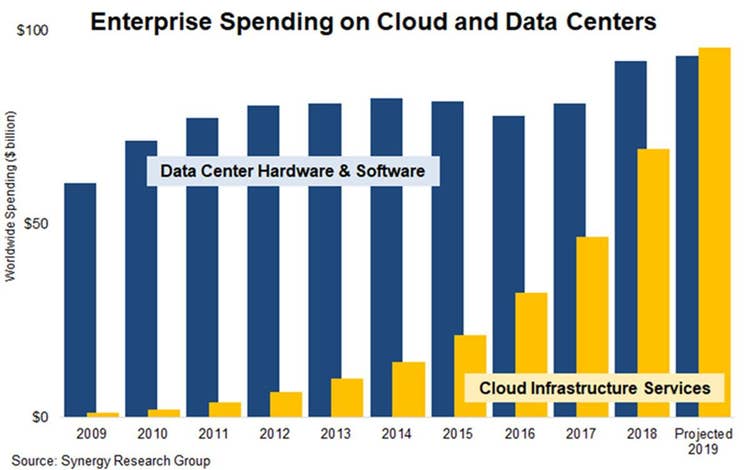Cloud Infrastructure Services Surpasses Data Center Spending In 2019
'Enterprises are speaking loudly via their wallets and channel [partners] cannot rely just on relationships with traditional hardware and software vendors,' says John Dinsdale, a chief analyst at Synergy Reach Group.

For the first time ever, enterprises are spending more money annually on cloud infrastructure services than on data center hardware and software, according to new data from Synergy Research Group.
In 2019, Synergy is expecting total spending on cloud infrastructure services to reach $97 billion, up 38 percent year over year. Total spending on data center hardware and software is expected to hit $93 billion in 2019, an increase of only 1 percent compared to 2018.
“Enterprises are speaking loudly via their wallets and channel [partners] cannot rely just on relationships with traditional hardware and software vendors,” said John Dinsdale, a chief analyst at Synergy Reach Group, in an interview with CRN. “Clearly, channel partners need to have a strong set of cloud service solutions in their portfolio and deep cloud service skills, if they want to remain relevant and successful.”
[Related: 5 Things You Need To Know About VMware’s Acquisition Of Pivotal]
Enterprise spending on their own data center hardware and software has been stagnant for a large part of the last ten years, while spending on cloud infrastructure services – such as Platform-as-a-Service and hosted private cloud – has skyrocketed.
From 2009 to 2019, annual spending on cloud infrastructure services has gone from virtually zero to almost $100 billion, growing 56 percent annually, according to Synergy. During the same 10-year time period, annual spending on data center hardware and software grew only 4 percent on average. Data center spending did witness a solid increase in 2018 thanks to more richly configured and higher-priced servers, although server unit shipments remained flat.
Dinsdale said the past decade has seen a “dramatic increase in computer capabilities, increasingly sophisticated enterprise applications and an explosion in the amount of data being generated and processed” which points to an ever-growing need for data center capacity. However, he said over half of the servers now being sold are going into cloud providers’ data centers – such as Amazon, Google and Microsoft -- and not enterprises’ data centers.
“Over the last ten years we have seen a remarkable transformation in the IT market. Enterprises are now spending almost $200 billion per year on buying or accessing data center facilities, but cloud providers have become the main beneficiaries of that spending,” said Dinsdale.
Amazon, Apple, Google, Facebook and Microsoft led the charge in terms of building new data centers in 2019, all of which are building hyperscale facilities that house tends of thousands of servers and hardware alongside millions of virtual machines.
Over the past decade, the major data center hardware and software segments with the highest growth rates were virtualization software, Ethernet switches and network security, according to Synergy. The biggest growth segments in cloud infrastructure services over the past ten years were within Platform-as-a-Service (PaaS) especially database, IoT and analytics.
In terms of channel partners, Dinsdale said solution providers need to embrace a solid mixture of cloud and on-premise solutions. “I’m trying to avoid the word ‘hybrid’ as it has become so hackneyed, but channel partners need to be able to effectively target enterprise needs that embrace a mixture of on-premise and cloud solutions,” he said.